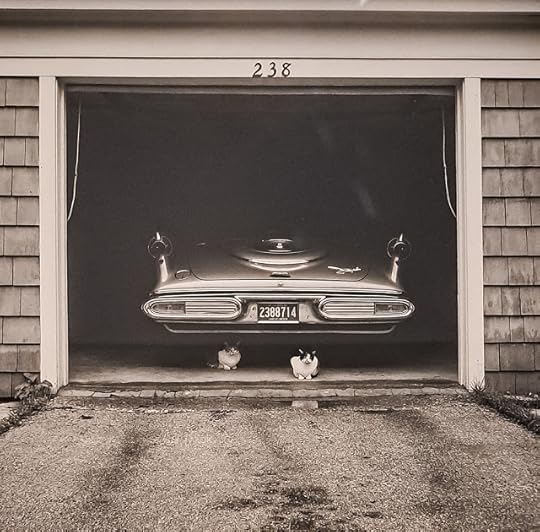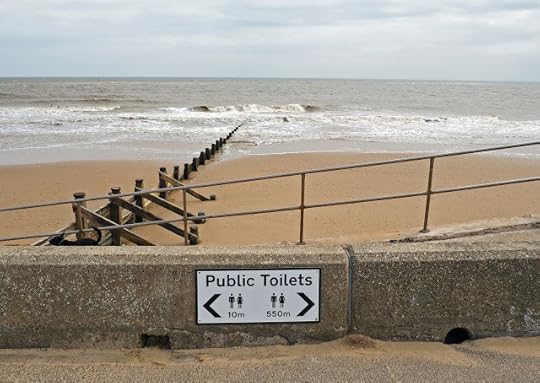Geoff Nicholson's Blog, page 2
October 9, 2024
WALKING AND DIFFERENCE
This is a photograph of Jaques Derrida walking:
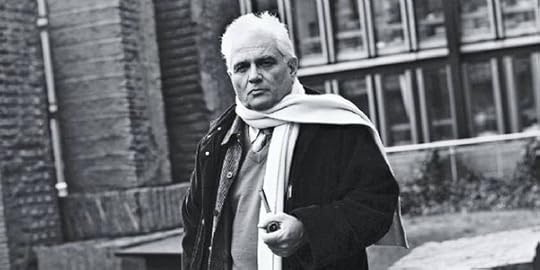
Derrida has been on my mind, well, more than usual, because I just read a review in the LRB, 10 October 2024, by Jonathan Rée, discussing the recent translations of Derrida’s Hospitality, Volumes 1 and 2.
Rée writes “Derrida had a marvellous literary range, and a sharp eye for details that might elude the rest of us. (Reading him reminds me of taking a walk with a friend who will spot a ghost orchid, a heath fritillary and an alpine swift while I am just enjoying a companionable stroll.”
This is a ghost orchid:
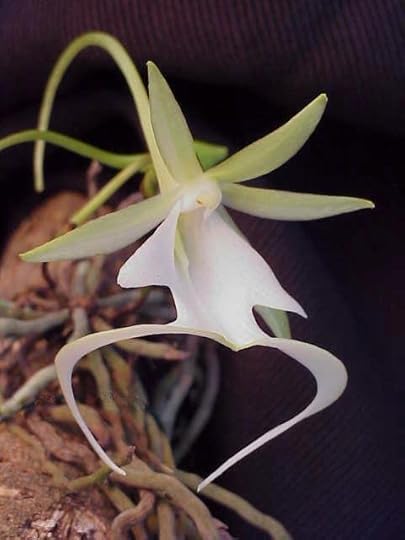
This is a heath fritillary:
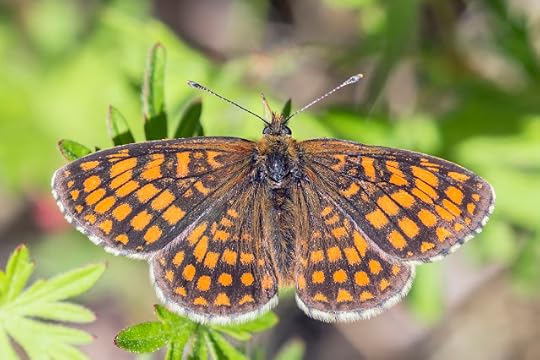
This is an alpine swift:

Speaking as someone who couldn’t identify any of those things, I do wonder whether it might not be rather annoying to walk with somebody who was constantly pointing out things that I didn’t recognize.
Though I suppose being with Derrida might create other irritations, such as his obvious vulnerability outside off stump.
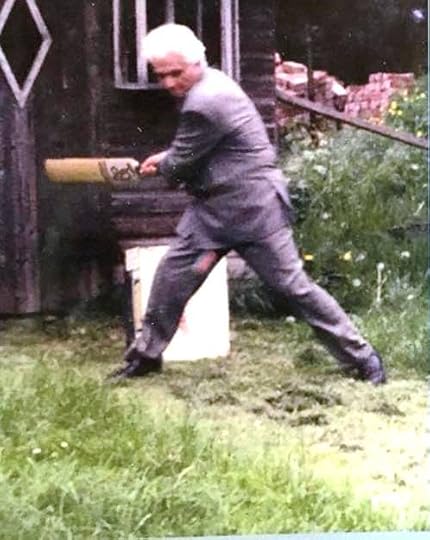
October 4, 2024
WALKING WITH ADDITIONS
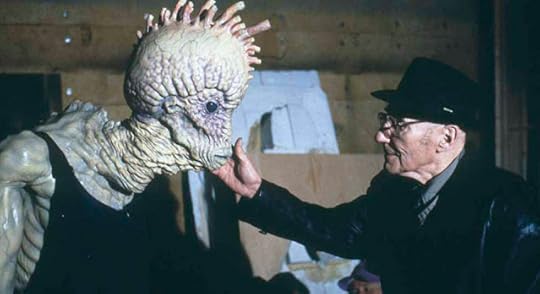
A note comes over the transom from Jane Freeman, one of my regular correspondents, also walker and top artist (she did some extraordinary pictures inspired by Jane Eyre) like this,
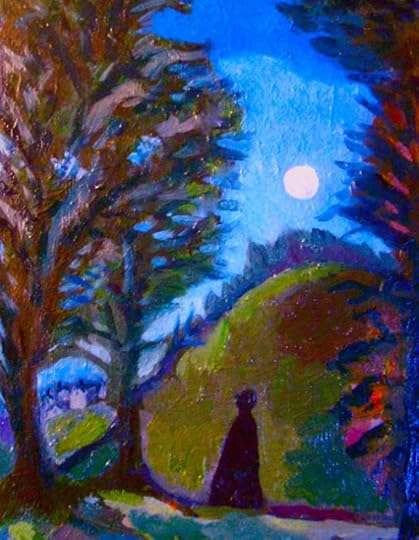
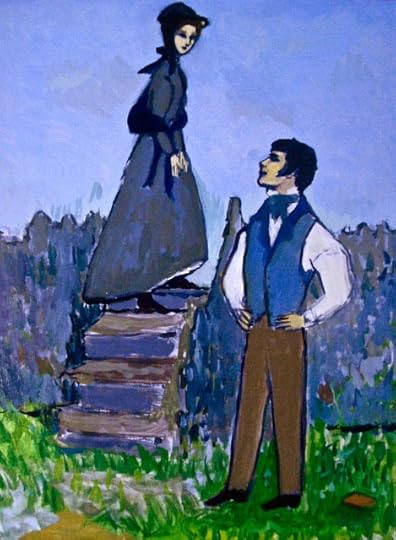
“Thank you, Mr. Rochester, for your great kindness. I am strangely glad to get back again to you: and wherever you are is my home—my only home.”
I walked on so fast that even he could hardly have overtaken me had he tried.
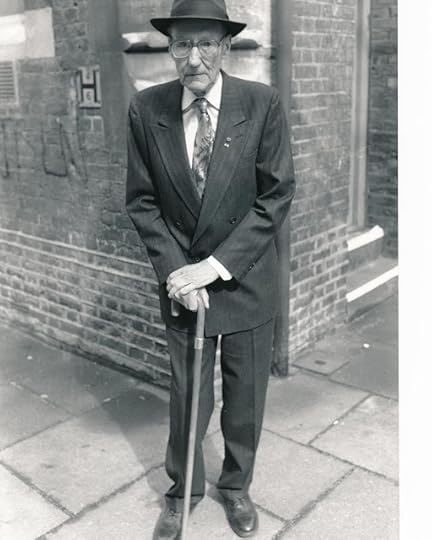
Jane reminds me about William Burroughs' ‘psychogeographic practice’ described as ‘Walking on Colours.’
Let Old Bill explain,“Pick out all the reds on a street, focusing only on red objects–brick, lights, sweaters, signs. Shift to green, blue, orange, yellow. Notice how the colors begin to stand out more sharply of their own accord. I was walking on yellow when I saw a yellow amphibious jeep near the corner of 94th Street and Central Park West. It was called the Thing. This reminded me of the Thing I knew in Mexico. He was nearly seven feet tall and had played the Thing in a horror movie of the same name, and everybody called him the Thing, though his name was James Arness. I hadn’t thought about the Thing in twenty years, and would not have thought about him except walking on yellow at that particular moment.” This is James Arness:
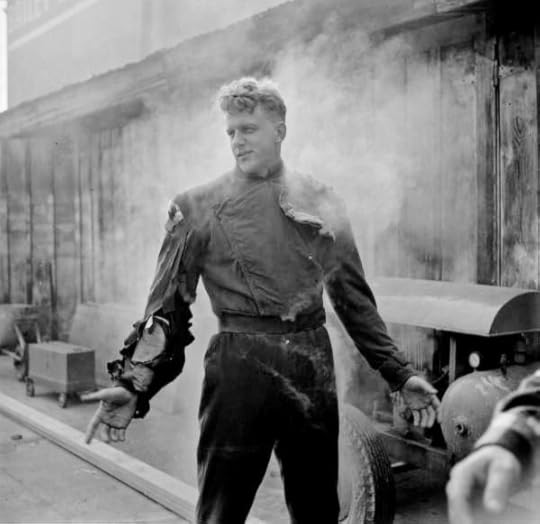
(The Thing of course is a Volkswagen Type 181, and if you think that sucker is amphibious, well good luck)

A lot the time I think I’m ‘over’ Burroughs, but then I reread something like that I think I’m not so over him after all. That passage is from “Ten Years and a Billion Dollars” and appears in The Adding Machine: Selected Essays, 1985. This is a man with an actual Burroughs adding machine:

I’ve never done the walking on colours thing and I suppose I’m unlikely to, being red/green colour blind. I’d be following what I thought was a red fire engine and then I’d suddenly realize, or somebody would tell me, I was actually following a green bus. I exaggerate, but only a little.

Admittedly blue and yellow should be less of a problem.
September 14, 2024
WHEREAS I ALWAYS THOUGHT THAT WOULD BE THE BEST PART
September 3, 2024
WALKING WITH ARCHITECTURE (AND CARS)
And so we went to Frinton on Sea, in Essex, and not for the first time.
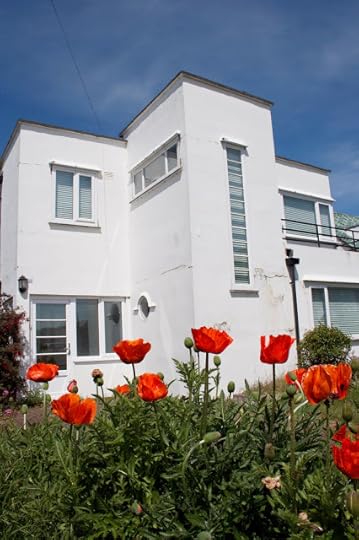
Like many people I usually go there to walk around and stare at the modernist architecture in the Frinton Park Estate and although we certainly did do that, I thought I needed a new angle, or at least variation on an old one. So I continued my comparatively recent obsession with circular windows, of which there was no shortage.


That was fine, but then I noticed there were also quite a few cool old cars on the street, which I hadn’t been expecting.
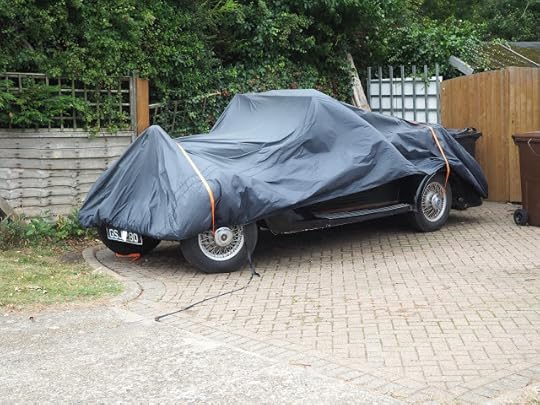
It’s an odd thing isn’t it, any walk, every walk, is improved by the presence of interesting or curious architecture and any street is improved by the presence of cool old cars

This is why American Street Photographers of the 1960s and 70s, most of them walkers by necessities, had life so easy in one sense. Point your camera towards a mid of mine-period architecture or even a garage, and include a car with fins, and it’s hard to go wrong.
But times change, I find modern architecture, whether good or bad, infinitely fascinating, whereas modern cars rarely look like anything at all. And it must be said that in Frinton I never found a cool car and a cool piece of architecture in the same frame, unless a marquee counts as architecture.

And I see there’s also a new book forthcoming from the modernist titled A Time ⋅ A Place, a book in which 'every "Car of the Year" (1964-1982) is paired with a building completed in the same year' - photographed by Daniel Hopkinson, researched and written by John Piercy Holroyd.
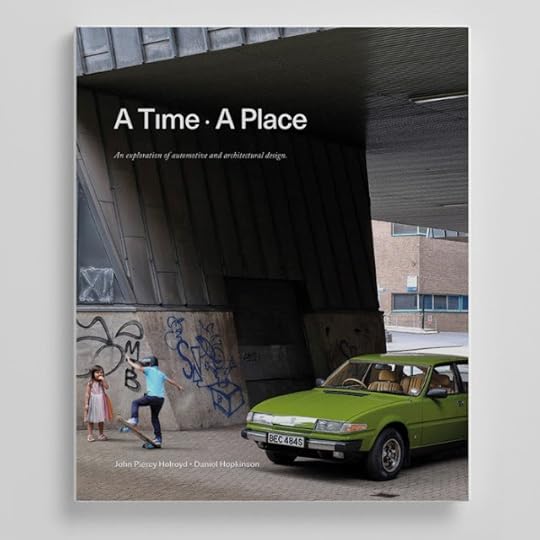
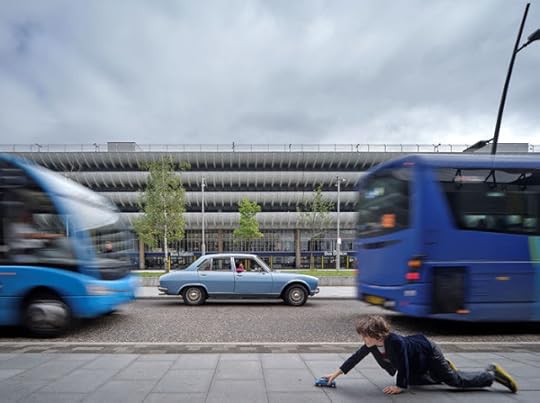
OMG, I can barely imagine the amount of work that went into that and I certainly didn’t put that amount of work into a day trip to Frinton, obviously.
There used to be a trope that said ‘Harwich for the Continent, Frinton for the Incontinent’ a sneer directed at old and weak-bladdered Essex holidaymakers. But insult or not, I found Frinton to be very well supplied with toilets, and just as important, very well signposted.
And the architecture of the main toilet on the sea front is understatedly epic – though you do have to pay 20 pence to get in there. A small price to pay.

August 28, 2024
TO BE A WALKING PILGRIM
Some folks walk the Camino de Santiago:

Some folks walk the Great Wall of China:

Some folks head for the deep north, like our pal Basho:

Me, I went to Walthamstow and walked from the tube station to see the Banksy mural on the side of Bonners Fish Bar (no apostrophe). It looked just like this – protective Perspex in place.
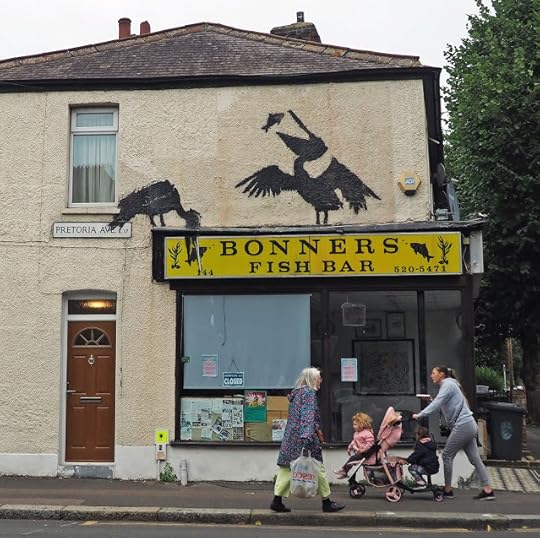
The shop was closed, and obviously had been for a while, perhaps for an annual summer holiday, and a great pile of mail had been pushed through the letterbox and was lying all over the floor.
It was a great missed commercial opportunity, I’d have thought – ‘Get your Banksy chip butty right here!’
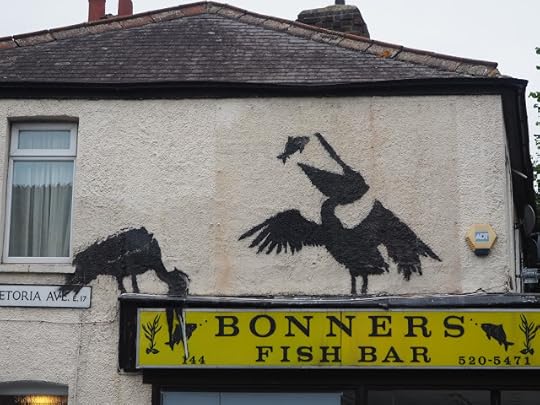
But Banksy wasn’t the only artist whose work could be seen as you walked the streets of Walthamstow. Here for example is the Walthamstow Sculpture Park, in somebody’s front window:
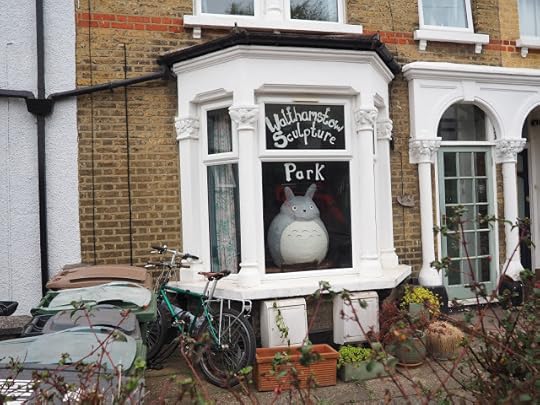
And here’s whatever this is:
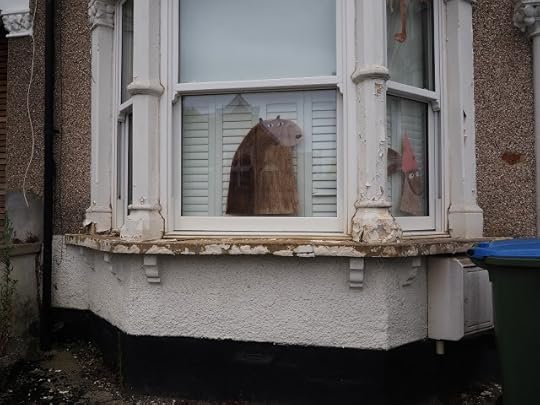
Sometimes it feels good to be a pilgrim.
August 23, 2024
THE PERFUMED CASCADE
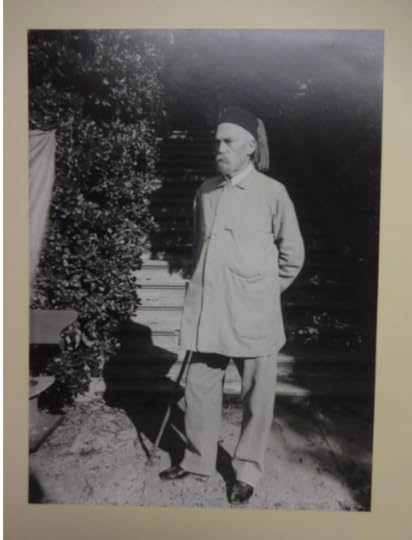
Regular readers of this blog (if there are any) may remember that about a year ago I agreed to lead a literary walk based in Richmond, and I had the idea of doing a route that took in the school where Sir Richard Francis Burton was educated (or at least taught), and ended at the Orleans House Gallery which houses the Burton Collection, an archive which among other gems contains plaster casts of one of Burton’s hands, and one of his feet – the left in both cases. I thought it would be a fitting climax to a walk if we ended up staring at a plaster cast of someone’s foot. The case looks like this on the Orleans House website.
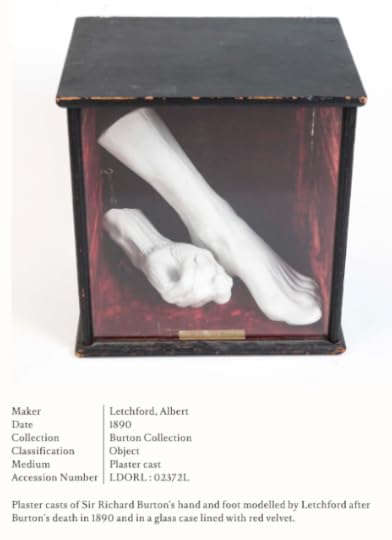
The idea didn’t come off because although the Burton Collection could, and can, be seen on request, the gallery at that time, they told me, was in the process of changing curators so things were ‘a bit chaotic’ and there’d be no chance of seeing it for a few months. So I led a different walk.
For some of us, Burton is a fascinating though paradoxical and contested figure, on the one hand an intrepid explorer, a proto-anthropologist and sexologist; on the other a man with some less than enlightened views on race and sex. I couldn’t have said that Burton had been ‘cancelled’ by Orleans House, but it certainly seemed he’d been sidelined.
Still, thanks to the good people involved with the Sir Richard Francis Burton Society, chiefly Martin Norris, a small group of us went into the collection recently and we were allowed an hour to look at, though not touch, items from the collection. These included, among other things, writing implements, a sword, photograph albums, a cigar case and a fez.
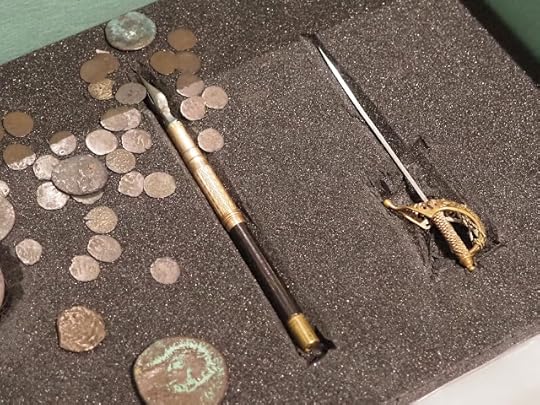

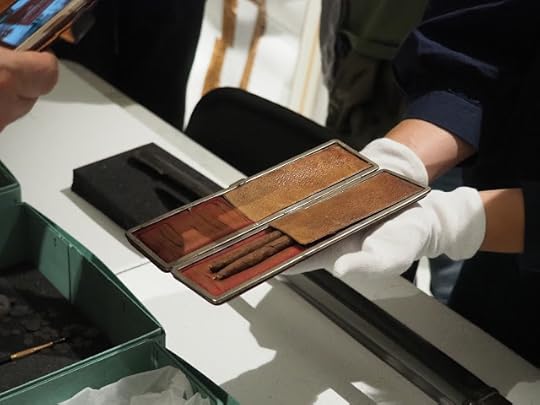
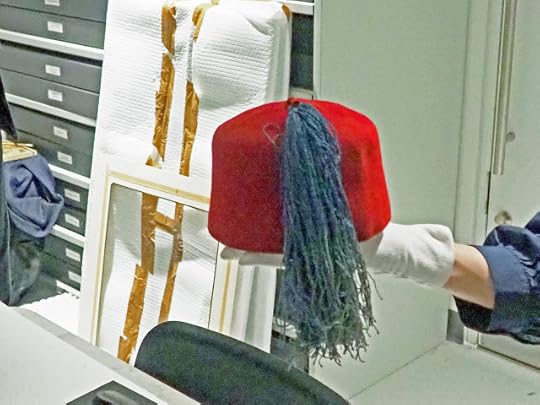
And there, sure enough, were the casts of Burton’s hand and foot. I took a photo - not a very good one because of the overhead lighting and all reflections - but at least it proves I was actually there.

I’m still working out how much of a walker Burton was, but one of the great things about our archive visit was a chance to look at some of Burton’s shoes. I’m sure you can tell a lot by looking at a dead man’s shoes. I recall being horrified as a kid when my grandfather died and various male relatives started trying on his shoes to see if they fitted and whether they could use them. Now it seems a perfectly reasonable and rather touching thing to do. There was definitely no trying on of Burton’s footwear, obviously.
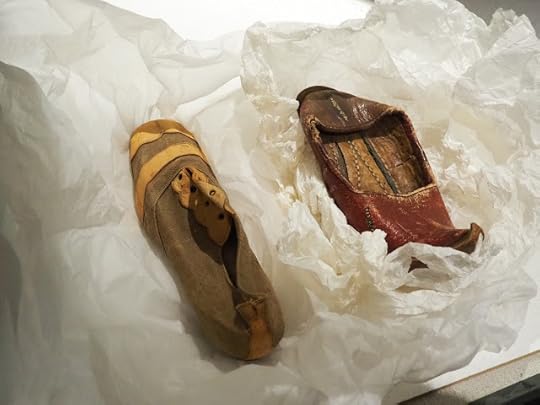
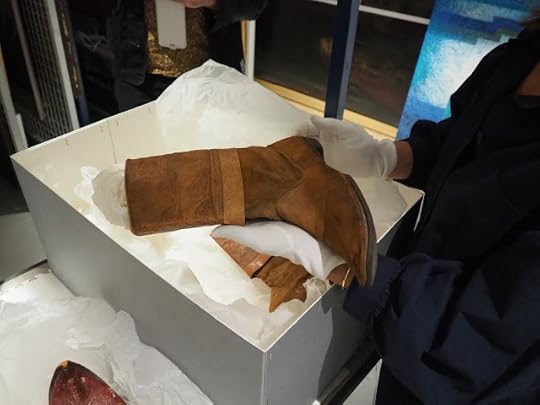
There were fencing shoes, slippers, a wooden clog, some very fine boots. The patterns of wear were interesting, at least one pair looked as though it might have been reheeled.
It was a great afternoon. The visit wasn’t exactly a walking expedition but we did walk to Orleans House from the pub where we met near Twickenham station, and on the way we saw a pair of marble buttocks peeping out at us over a wall and behind railings. So on the way back we took a closer look.
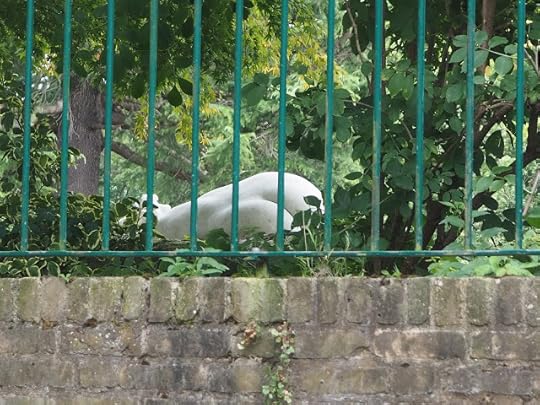
The buttocks belong to one of a number of Carrera marble statues, the Oceanides, part of the York House Cascade, in York House Gardens.

Like Burton himself these do have a convoluted history. As I understand it, they were carved somewhere near the turn of the 19th to the 20th century by Oscar Spalmach, and they passed through the hands of Whitaker Wright, who intended to use them at his estate in Surrey. However, in 1904 Wright was found guilty of fraud, and committed suicide by swallowing cyanide in an anteroom of the Royal Courts of Justice.
York House belonged to Sir Ratanji Tata, described by some sources as ‘an Indian merchant prince’ and he bought the statues in 1909, still in packing cases, to adorn his property. Tata died in 1918, and when his wife returned to India she sold York House to Twickenham Urban District Council for use as municipal offices, and the statues were part of the deal. After many decades of neglect and vandalism the statues were eventually saved and restored.
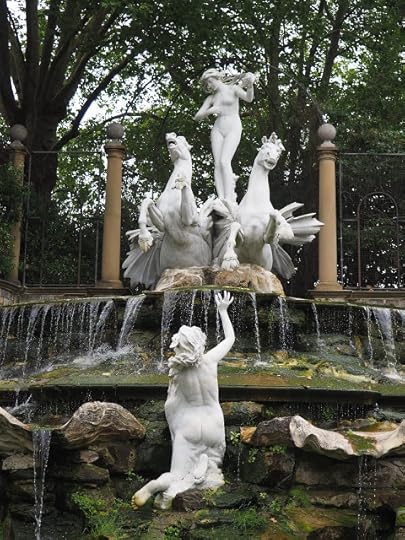
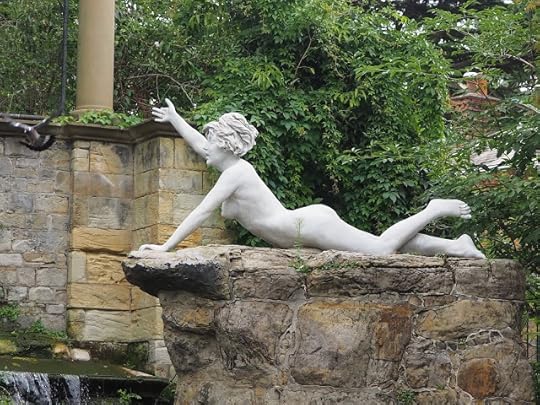
And there they are today, naked, shameless, uncancelled. Sir Richard Francis Burton would surely have loved them. The Oceanides – not a pair of shoes between them.
August 8, 2024
TIME OF THE SIGNS
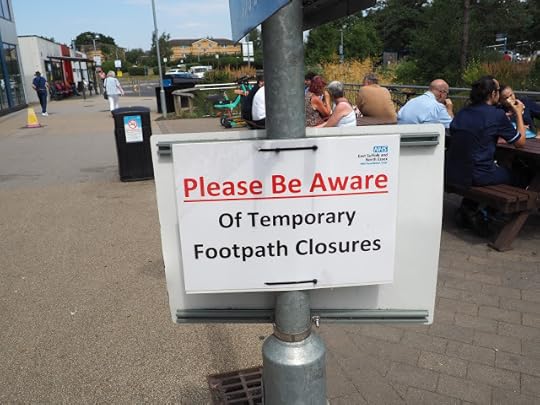
I enjoy a good sign while I’m walking. Who doesn’t? They can be informative, decorative, perplexing, absurd, and no doubt many other things too.
Suppose you were walking in Myland (it’s part of Colchester) and you saw this one ‘Myland Welcomes Careful Drivers,’
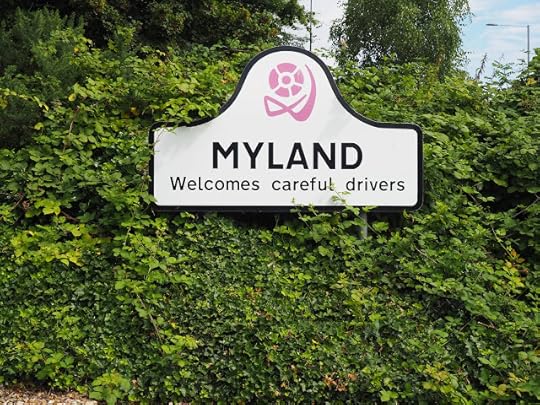
Would you think,
a) that they don’t welcome careful walkers?
b) that you can walk as carelessly as you like, and you’re still welcome?
Or would you have better things to think about?
Signs with missing letters are always fun and in this case there’s no doubt what the sign means, but it does make me wonder how many letters a sign can lose before it becomes utterly incomprehensible.

That temporary bus stop sign had obviously seen a lot of use but nearby was this absolutely pristine sign telling me that the crossing was out of use. I suppose time will take its toll.
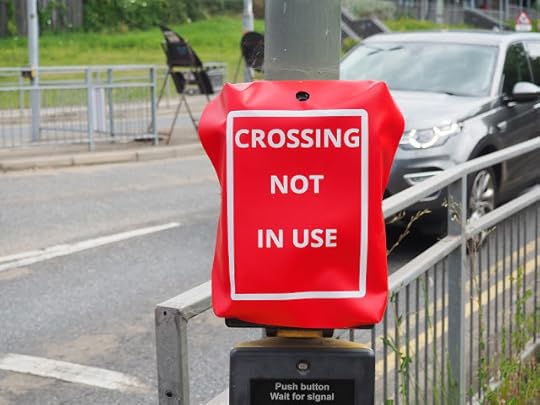
Not so far away was this, a signal, rather than a sign.
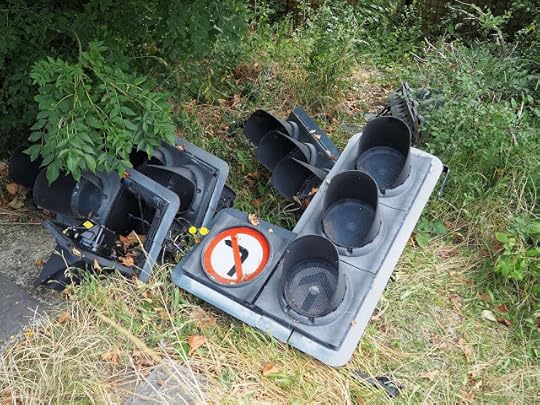
And here’s a sign from the company in charge of the discarded lights, temporary bus stops and out of order crossings, and no doubt much else:

I didn’t even know there was any such thing as the ‘Traffic Industry.’ ‘What you doing these days Bob?’ ‘Oh I’m working in the Traffic Industry, you know, supporting it.’
Of course it’s always good for a walker to be warned when the footpath (or indeed footway) ahead is closed:
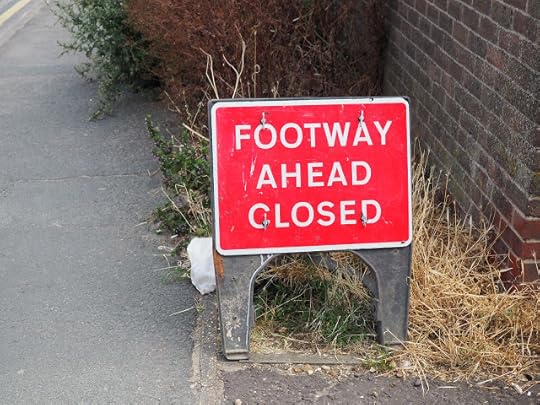
but it’s a little disappointing when you get there and find it’s not so much closed as very slightly diverted:
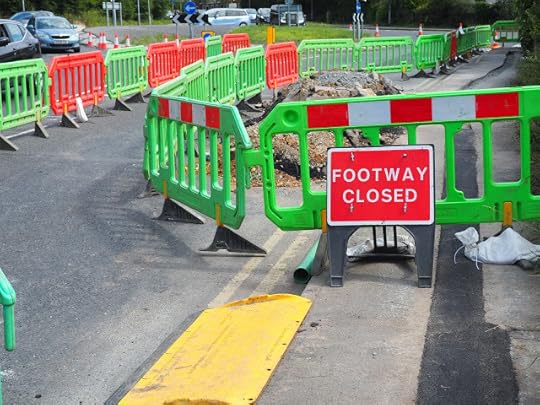
Now, if you’re looking for the ‘site compound’, it’s no doubt very useful to have a sign directing you there, though this one does seem to be up in the sky.

As for parking regulations – forget about it:

And finally in the Asda car park, at the end of my walk, there was a sign telling me to have a safe journey, which I’d already had, but no doubt there are other journeys ahead, which I hope will be safe, and maybe signs will play their part.

August 5, 2024
BRIGHTER THAN DORIS DAY? WELL NO, DON'T BE RIDICULOUS, HOW COULD IT BE?
So off we went for a walk at the seaside, in Brightlingsea. I’d never been there before. When I was doing an MA in Modern European Drama at Essex University, thereby guaranteeing my unemployability, I used to see many buses with Brightlingsea on their destination boards, but I never got on one of them. So off we went.
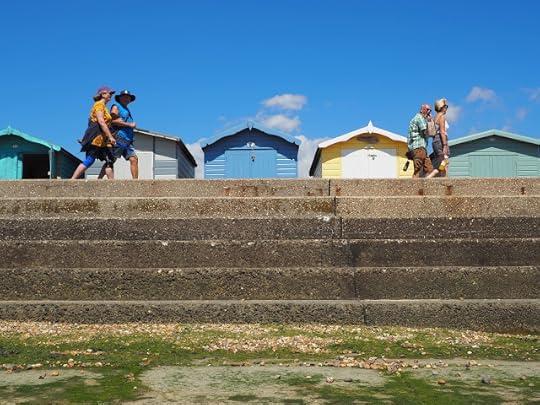
It was a hot Sunday afternoon. There were a lot of people walking, some more stylishly than others.
Now I’m no body fascist, much less a fat-shamer, but I mean, really some things are just better covered up.
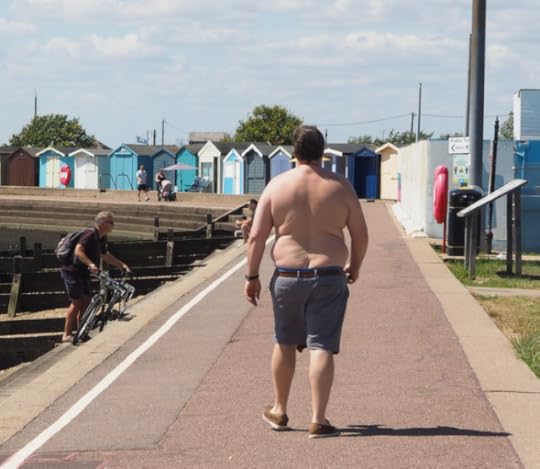
It’s not only the groynes you need warning against.
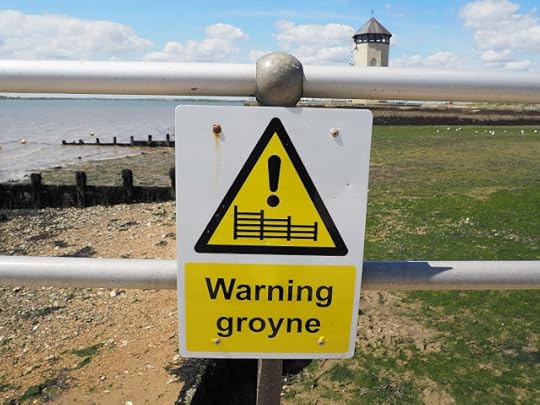
There were some top quality beach huts, this one with a skull and crossbones. Everything’s better with a skull, IMHO:

And on the beach we found a Henry-Moore style rock. I’ve noticed before that on the beaches of Britain you used to find endless rocks and stones with holes going right through them. These days there are a lot fewer. The obvious reason is that people pick up the ones with holes and take then home and put a string through them and hang them up, but no doubt there are other possible explanations. This one stands, or I suppose reclines, alone without need of string:
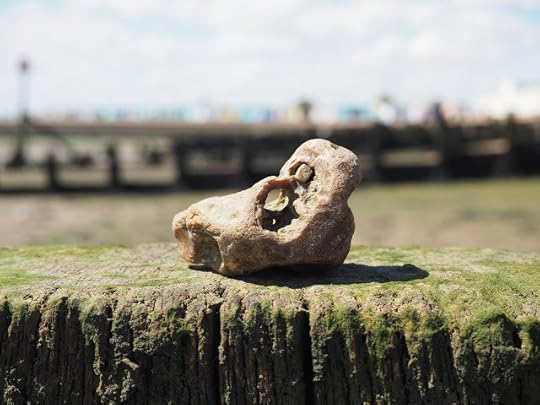
In the town there was a marker for the ‘1953 surge,’ part of the devastating East Anglian floods.
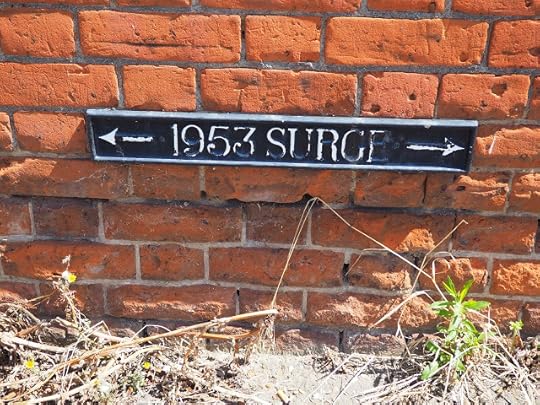

And there was a place to put your not quite extinguished cigarettes, which looked to me as though there had been a certain amount of after-the-fact combustion.

Will it surprise you to learn that this was at the fire station?
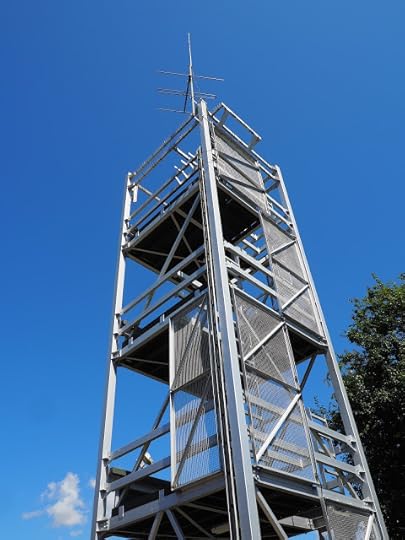
And we walked in The Lozenge – a ‘nature area … bringing you closer to nature, 9am till dusk March to end of November.’
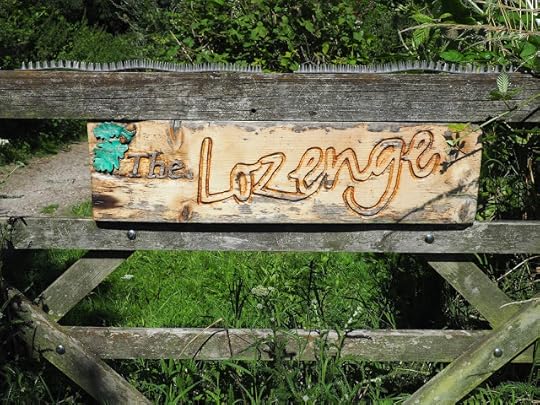
You know how I like maps, this one in dappled sunlight, with a teasel, was the business – mapping the bench and the bin; the important stuff:
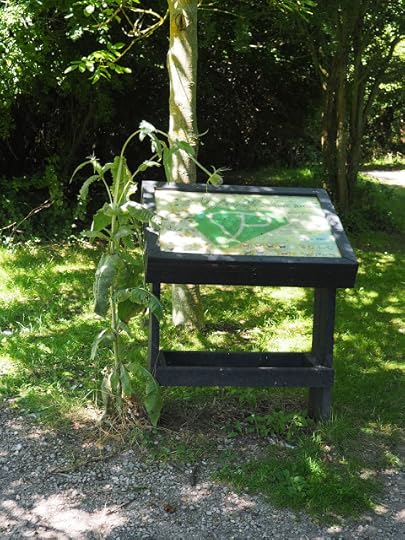

The best thing about the Lozenge: me and the inamorata were the only ones there. I suppose some people wanted to be closer to the food trucks than to nature. And here was a gentle reminder to make up your bloody mind about what you want before you get to the front of the queue.
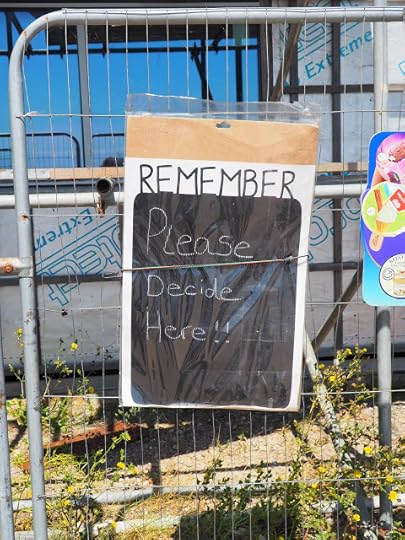
July 30, 2024
WHITE WALKING
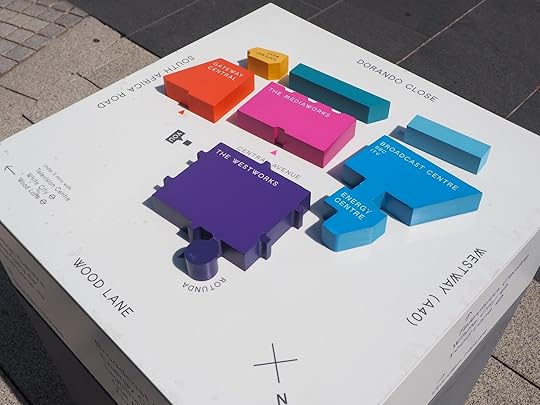
I went to London to see my doctor who told me I was still alive, which seemed like good news. So the next day I went for a walk in and around White City, with my boon companion Ashley, flaneur of that parish, more or less. The temperature and the humidity were punishing so we didn’t walk as far or with as much zest as we might have in other circumstances.

Reader, it felt, at first, like walking in the future. There were shiny, fresh-out–of-the-box buildings with no indication of what went on inside them. There was free wi-fi outdoors in public spaces that had lots of places to sit. There were chain restaurants I’d never heard of before - Potager and Dear Grace – and the latter had set up a giant screen outside for those who wanted to watch the cricket. On a different day that would have been me.
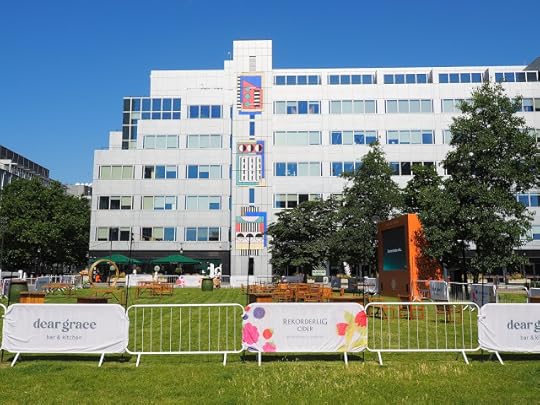
In fact there were some buildings I could tell the purpose of; a mighty concentration of places where people lived, developments with names like White City Living, Cascade Apartments, Belvedere Row and the improbable Bowery Apartments. These mostly looked pretty good architecturally, and completely unaffordable.

I’d been to White City once or twice in the past, when I’d had some business or other at the BBC TV Centre. The BBC building remains, but is also converted into swanky flats, though there’s still a naked golden statue of Helios at the centre of the garden. If the sun god isn’t permanent, what is?

Although this White City walk was just a meander, there was a general plan to go and look at (and walk in) the Japanese Garden in Hammersmith Park – which dates from 1910, and was originally part of the Japan-British Exhibition held to strengthen the Anglo-Japanese Alliance. It’s a long story which I won’t tell here, though it's worth noting that White City was then part of Shepherd's Bush, which in many ways it still is.
Photographs from the time show it to have been a wild and complex affair, and it must have required a huge amount of work for what was a very short-lived exhibition.
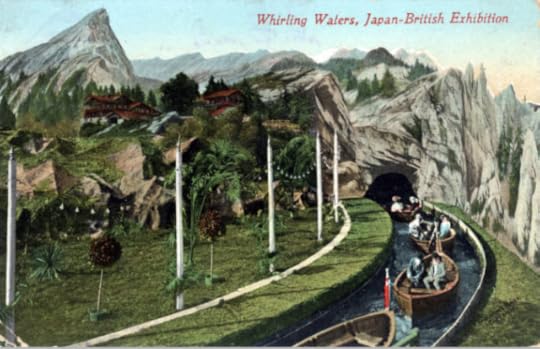
There were two gardens at the exhibition, The Garden of Peace and the Garden of the Floating Isle. Now there’s only one: ‘The Garden of Peace was converted into a more traditional British public park named “Hammersmith Park”’ – I’m quoting here from the Japanese Garden Society.
I’m surprised, and pleased, by how many Japanese gardens there are in Britain - at least thirty open to the public – from Lowther Castle to the St Mungo Museum of Religious Life and Art, from Dartington Hall to the National Botanic Garden of Wales, and so on. I confess I haven’t walked in all that many of these.
I suppose this prevalence of Japanese gardens may possibly be because the features of a Japanese garden are easy to identify and easy to replicate: like these lanterns in Hammersmith Park, sponsored by various Japanese corporate interests.
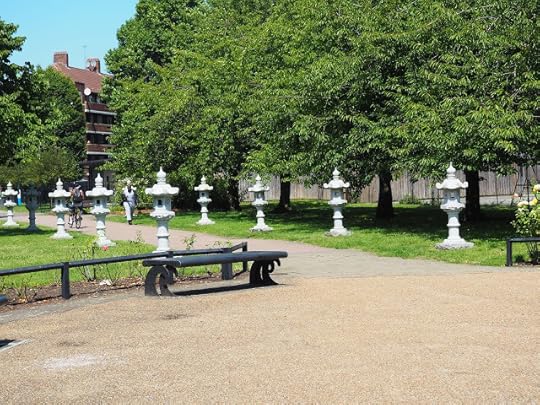
There is also a type of Japanese garden called (at least by English speakers) a ‘stroll garden.’ just right for walkers, or meanderers, like me. This one’s in Kew.
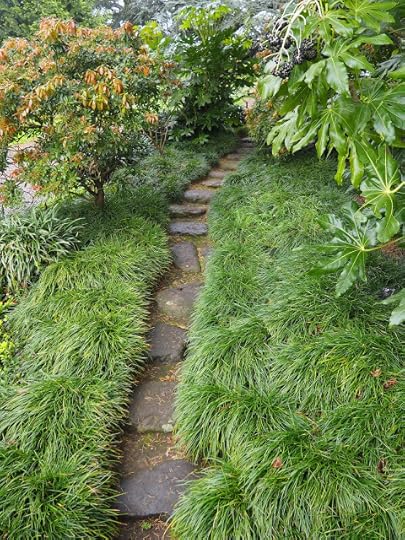
In the Japanese Garden in Hammersmith Park on the day I was there, a few homeless people were setting up camp, and a few young women in bikinis were sunbathing but I thought it best not to photograph them.
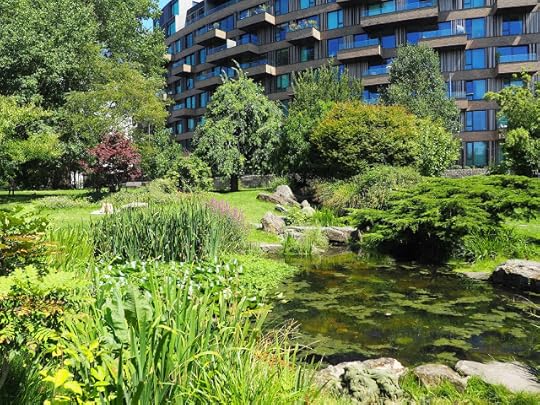

Adjacent to, or possibly part of, the Hammersmith Park is something called the Wood Crescent Playground: you know, for the kids.
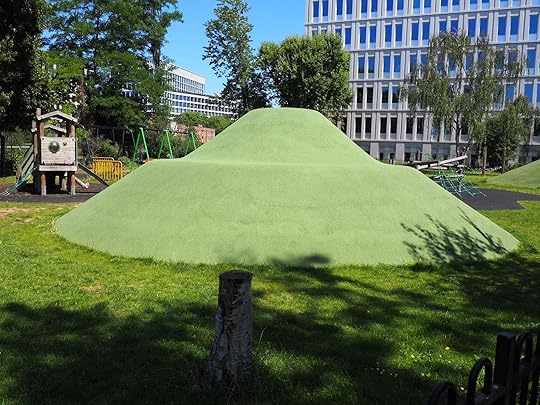
And as we walked around, a moment came when I looked at the mound in the playground (above) and it reminded me powerfully of this other mound in the Jencks Garden of Cosmic Speculation, near Dumfries, (below).
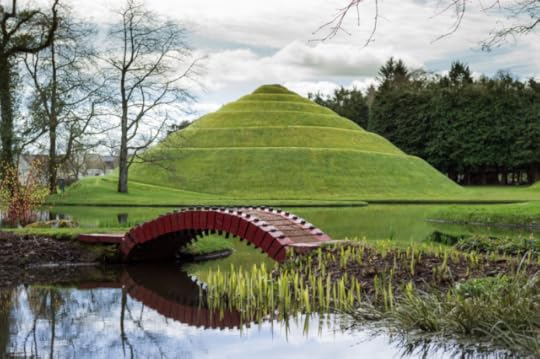
Possibly the heat was getting to me.
July 21, 2024
EDDIE AND ME
More than half a lifetime ago, I was (for want of a better term) a security guard at the Hayward Gallery for their Thirties exhibition, and one of the items I had to guard was this head of Sir Edwin Lutyens. (Sometimes it’s referred to as a bust.)

I might just about have heard the name Lutyens before I worked at the Hayward, but only just. Nevertheless I loved that head: how could you not? And to be fair it didn’t need much guarding.
My job was by no means a walking job but we weren’t allowed to sit down and so we paced up and down the galleries hour after hour, day after day, as a deterrent.
Walking in galleries can be hard work even when you’re keen to see the exhibition; walking back and forth when you’re just a deterrent is much harder.
I gather that the head belongs to the Victoria and Albert Museum and it incorporates Lutyens’ design for the Viceroy's House in New Delhi, now the Rashtrapati Bhavan.
And then last week I was walking round the Victoria and Albert as a punter not a security guard, there to see the Tropical Modernism exhibition, and there was old man Lutyens again. It felt like meeting an old friend.
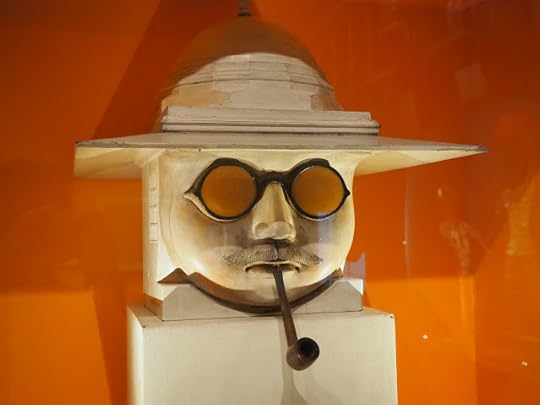
Judge for yourself whether it's a good likeness.
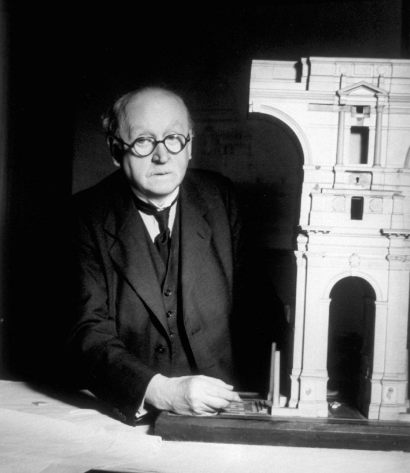
Geoff Nicholson's Blog
- Geoff Nicholson's profile
- 55 followers




